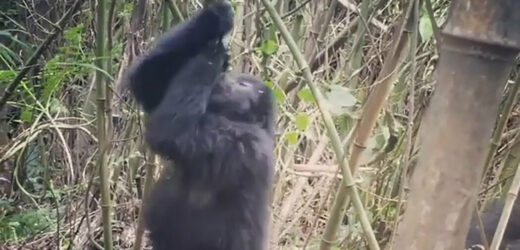In 2011, a gorilla named Zola gained internet fame when the Calgary Zoo posted a video that showed him spinning in circles on his knuckles and heels with what appeared to be a huge grin on his face. Zola, the so-called break-dancing gorilla, returned in 2017, this time in a video showing him whirling around a kiddie pool with a level of wild enthusiasm rivaling the most committed human dancer at an all-night rave.
Humans’ love of spinning around in circles, especially during childhood, is evidenced by the enduring popularity of playground merry-go-rounds, revolving fun park rides and the irresistible draw of somersaulting down a hill. But new research suggests that humans are not alone in their pursuit of spin-induced buzzes.
According to findings published last month in the journal Primates, other great ape species also seem to regularly enjoy stimulating their senses through spinning, possibly even in pursuit of altered mental states.
“Spinning around to make ourselves dizzy is something we usually think of as a distinctly human activity,” said Marcus Perlman, a cognitive scientist at the University of Birmingham in England and an author of the study. “So it’s really cool to find that other primates do this, too, and that they seem to do it for the same reason that children do: because it’s fun and exhilarating.”
After Dr. Perlman saw the videos of Zola, he turned to YouTube to investigate whether other apes engaged in the behavior. He amassed nearly 400 videos showing great apes and other primates engaged in spinning behaviors, including somersaulting, rolling down hills, backflipping and pirouetting. But the new paper focuses on clips of apes spinning on ropes or ropelike materials.
Dr. Perlman and Adriano Lameira, a primatologist and evolutionary psychologist at the University of Warwick in England, found 132 instances of rope-spinning across 40 videos involving orangutans, gorillas, chimpanzees and bonobos. The videos mostly featured captive apes, but several involved wild mountain gorillas on vines.
The researchers calculated the speed at which the apes spun. Most of the apes, they found, spun at an average rotation velocity of 1.43 revolutions per second — a speed rivaling professionally trained human dancers and aerialists. The longest spin session lasted 28 revolutions, and the fastest — achieved by a bonobo — clocked in at a brain-scrambling four revolutions per second.
The researchers observed that the longer an ape spun, the more likely it was to show signs of dizziness, such as letting go of the rope and immediately sitting or lying down. Apes tended to repeat the process of spinning and stopping, engaging in an average of three bouts of spinning per session.
The animals also often made “play faces” while spinning, Dr. Perlman said, implying that they were most likely having fun rather than only seeking a way to relieve themselves of boredom in captivity.
“There’s something about the experience they enjoy,” Dr. Perlman said.
Catherine Hobaiter, a primatologist at the University of St. Andrews in Scotland who was not involved in the research, concurred. Based on her observations in the field, she said, “wild apes love to spin.”
Apes and some other animals are known to engage in other activities that can scramble the senses, including consuming fermented fruits containing alcohol and ingesting naturally occurring psychedelic substances. Whether this is done on purpose or by accident is debated, Dr. Perlman said. But studies such as this one can begin to provide data needed to explore behaviors that may be evolutionary precursors to the human desire to experience altered mental states.
Dr. Perlman is planning a larger study that will analyze hundreds of additional videos of nonhuman primates spinning. He has also started collecting evidence of other species, including grizzly bears and pandas, that appear to enjoy activities that may make them dizzy.
Marc Bekoff, an emeritus behavioral ecologist and cognitive ethologist at the University of Colorado, Boulder, who was not involved in the study, said researching such behavior was valuable “because there’s no a priori reason to think we’re the only animals who engage in behaviors that intentionally produce altered states of consciousness.” He added, “Systematic research will help us learn more about the taxonomy of getting high and not run around thinking we’re all that unique.”
Source: Read Full Article



